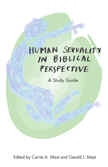| DFD |
||||||
|
This study guide provides an opportunity to explore biblical understandings of human sexuality, and our stewardship of sexuality, as expressed in two documents released by Central District Conference (CDC), a regional conference of Mennonite Church USA. The first document is a statement made in 2014 by the conference’s Ministerial Committee explaining their decision to license a pastor who is a gay man (see Appendix B). The second document was composed by a task group of the conference charged with creating a new statement that reflects CDC’s emerging understandings of sexuality. The document provides biblical and theological reasons for these emerging understandings, which express “faithful dissent” to some traditional teachings about sexuality and marriage and affirm nonconformity to narrow worldly judgments about sexual norms. These understandings have been displayed in decisions made by many congregations of the conference to more fully include sexually nonconforming people and their families in the life of the church. The conference leadership regards these decisions to be consistent with historic Mennonite commitments to social nonconformity as a practice of Christian discipleship. Thus, in this study guide, we speak of sexual nonconformity as a positive good that challenges the whole church, by the mercies of God, to conform to Jesus Christ rather than to the dividing and excluding patterns of the world (Romans 12:1-2). This commitment to an embracing biblical nonconformity links the discussion of human sexuality in this guide with a range of other topics and experiences, such as family life, sexual abuse, pornography, divorce, violence, biblical interpretation, and more. Of course, members of the church are not always agreed about how to apply biblical convictions. During the past ten years, CDC conference assemblies have generally affirmed the actions of inclusive congregations and pastors, even while some leaders and congregations in the conference have also raised questions and concerns about this direction. Such questions and concerns have been expressed in a variety of venues: open-mike opportunities at annual meetings, regional gatherings, conversations with our conference minister, letters to the board of directors, and decisions by congregations to withdraw from the conference. Mennonite Discussions and DecisionsThe decisions and discernment of Central District Conference about human sexuality have taken place against the backdrop of its relationships with the network of conferences known as Mennonite Church USA. The process of discussion and discernment about same-sex relationships within that larger network has been unfolding for the past three decades, beginning with developments in the two predecessor denominational bodies: the General Conference Mennonite Church and the Mennonite Church. In July 1986, the General Conference Mennonite Church met at Saskatoon, Saskatchewan, and passed a resolution on human sexuality that affirmed the goodness of human sexuality, confessed to judgmental attitudes that included the rejection of those with a different sexual orientation, and established a covenant to continue to discern and to remain open to dialogue on these matters. At the same time, the resolution confirmed the church’s understanding that sexual intercourse is reserved for a man and woman in marriage. A year later, the (Old) Mennonite Church made a similar resolution at their assembly at Purdue University in West Lafayette, Indiana. Since the 1980s, the Saskatoon and Purdue statements, along with Human Sexuality in the Christian Life, published in 1985 as the official church study guide on this topic, have served as landmarks in the discussion of human sexuality in the Mennonite churches. Most official statements of Mennonite churches, conferences, and other bodies have reflected their commitment to heterosexual marriage while becoming more explicit about their condemnation of same-sex unions or marriages. The 1995 Confession of Faith in a Mennonite Perspective, which established the doctrinal unity upon which Mennonite Church USA was formed in 2002, stated in article 19 that “we believe that God intends marriage to be a covenant between one man and one woman for life.” Meanwhile, convictions and perspectives on human sexuality have continued to change in the church as relationships that do not conform to traditional heterosexual marriage are blessed by some congregations and bear good fruit. Some see this change as a clear departure from faithfulness and from the Bible while some see it as evidence of the Holy Spirit’s direction toward a more inclusive and embracing church. Others see it as a call into an unspoken liminal or in-between space marked by love for others without a clear sense of how this in-between space lines up with biblical and theological values. Liminal space like this has been part of the church’s experience during changing perspectives on most issues, whether it is the wearing of a prayer veiling or the acceptability of divorce and remarriage. In such cases the church has not typically worked out an acceptable theology before changing its practice but rather searched the Scriptures for wisdom about how to address challenges that were already changing the church. For example, growing discomfort with slavery in the nineteenth century led the church to read the Bible in new ways, seeing for the first time the prophetic challenge to human enslavement and the jubilee promise of liberation that was there all along. Just as theology is a matter of faith seeking understanding, so is ethics often a matter of changing practice and new awareness seeking biblical and theological footing. During the thirty years since the Saskatoon and Purdue statements, the church (like the surrounding society) has been faced with new challenges and insights concerning sexuality, especially focusing on concerns involving same-sex relationships. More broadly, the issues of sexual relationships and intimacy outside of marriage—for single persons of all ages—have confronted both society and congregations. None of these concerns is likely to disappear, and the church has not found consistent and helpful responses to these questions either by ignoring the concerns or by uncritically restating what has been said in the past. Neither, however, is the church well served by simply dismissing traditional wisdom. Instead, this situation calls on us as followers of Jesus to return to the source of all wisdom and to examine the scriptures again in light of the way Jesus responded to and talked about human relationships (at least implicitly including sexuality). In the
Anabaptist tradition, discernment about faithful Christian discipleship
takes place in congregational discussion and decisions, as well as in
exchanges of counsel among congregations and church leaders within the
broader network of the conference. Consistent with these commitments,
the Saskatoon and Purdue resolutions of 1986 and 1987 established a
covenant for Mennonites to mutually bear the burden of remaining in
loving dialogue with each other in the body of Christ, recognizing that
we are all sinners in need of God’s grace and that the Holy Spirit may
lead us to further truth and repentance. Testing and Confirming DirectionAs noted earlier, this guide displays the counsel represented in two documents produced through various discernment processes in CDC: 1) “Theological Foundations for Credentialing” (see Appendix B); and 2) “Human Sexuality: A Biblical Perspective.” The study guide offers this counsel in a format and style suited to study and discussion within a variety of settings and formats as described in Appendix A. Most of the content of the second document is included throughout this study guide, even though the content is organized somewhat differently and a substantial amount of new material has been added. The exact text of the original “Human Sexuality: A Biblical Perspective” document may be found at the CDC website. With prayer for the Holy Spirit’s guidance, we offer this study guide as one way to test the direction the CDC is moving. Many voices have contributed to this project: the ministerial committee, the human sexuality task group, the editors, the illustrator, the designer, the publisher, the conference leadership, and a host of additional voices from our conference both affirming and critical. Earlier drafts of the guide have been tested in regional conference gatherings, in congregational Christian education classes, and with conference pastors and teachers. These discussions have led to substantial revisions to the study guide, including greater attention to biblical texts that seem to address same-sex attraction, clear confrontation of violence and abuse in sexually intimate relationships (whether outside of or in marriage), and more clarity about the approach to biblical discernment displayed here. We are grateful for all of these voices that have contributed through an Anabaptist process of giving and receiving counsel to bring this study guide to fruition. The final text should not be regarded as a consensus document since it is unlikely that any person involved in the process (including the editors!) agrees perfectly with every single sentence or statement. Instead the text of the study guide should be regarded as a snapshot of a discernment process by one group of God’s people who are walking together on the road of discipleship. For the CDC, the covenant to dialogue expressed in the Saskatoon and Purdue resolutions has led us during the past thirty years to “further truth and repentance” as represented in the theological and practical understandings displayed in this study guide. We have experienced the presence and confirmation of the Holy Spirit in our discussions and decisions, even when these discussions have included disagreement. Perhaps most profoundly, we have experienced the great joy of reconciliation as our conference has extended the hand of fellowship to brothers and sisters in Christ from whom we had at one time been alienated because of previous judgments made by conference and denominational bodies. We are grateful
for those whose voices and lives have helped us to discover the
wideness of God’s mercy. We are also thankful for those whose
persistent questions and challenges have helped us to remain
accountable to the wisdom of tradition. We commend the knowledge we
have discovered in our brotherly and sisterly conversations to the
church for further testing and confirmation—as well as for the moral
and spiritual guidance we have found in our study of the Bible during
changing times. |
||||||






